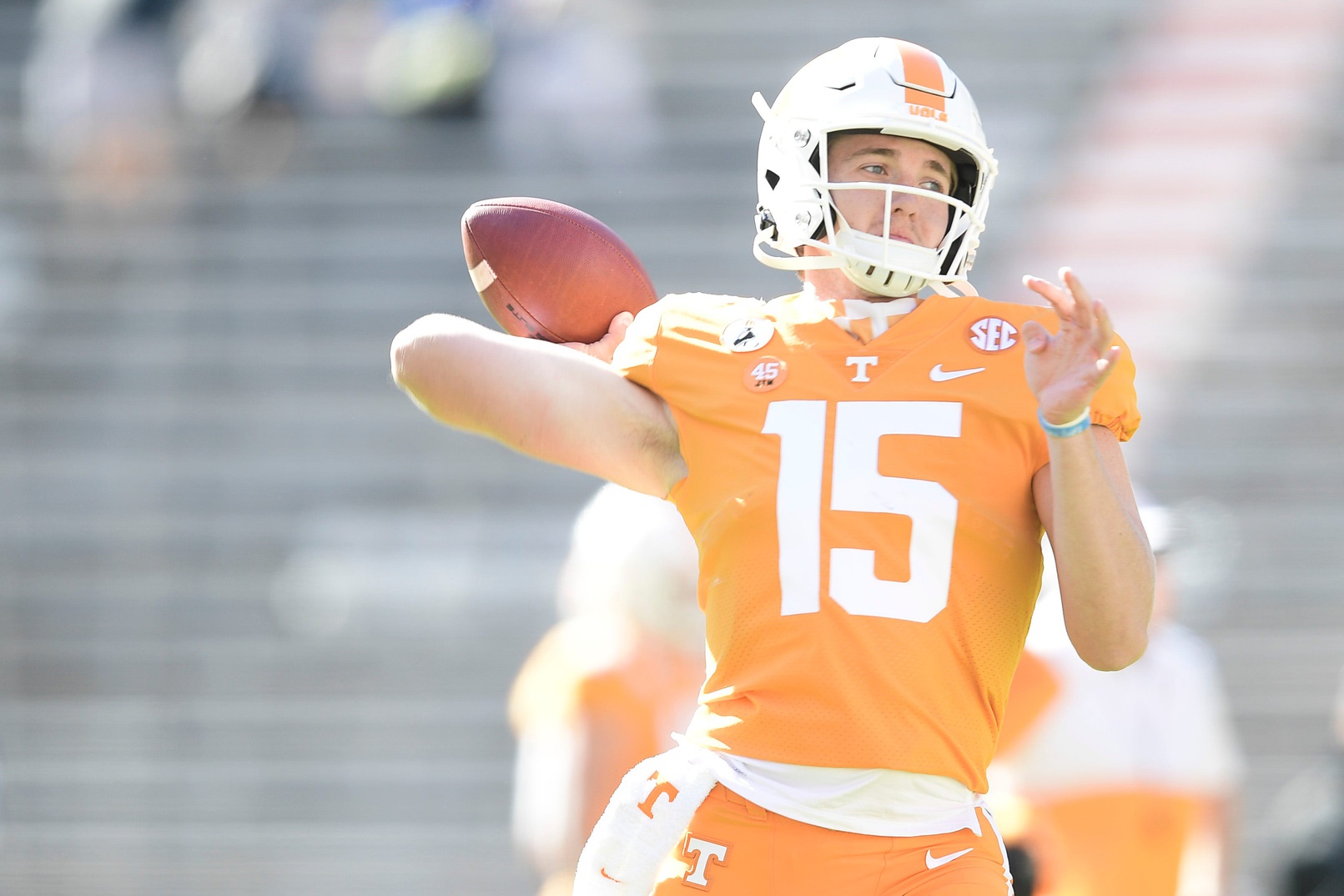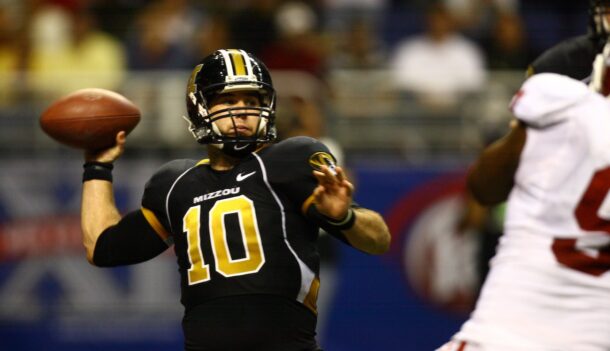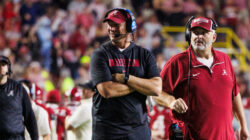
Does Josh Heupel’s arrival mean Harrison Bailey (or another Tennessee QB) will take off? A breakdown
Who knows what Tennessee’s future holds. One thing we do know? The offense will look much different under the new regime, led by Josh Heupel.
That’s a forgone conclusion, and not just because the Vols watched 3 of their 4 quarterbacks who took a 2020 snap enter the transfer portal at season’s end. The one who didn’t, Harrison Bailey, appears to be on board with his new coach.
Bailey welcomed Heupel on board with this tweet:
Excited and locked in.. 🍊 #LetsWork @coachjoshheupel
— Harrison Bailey (@HBailey_05) January 28, 2021
Hendon Hooker, who transferred from Virginia Tech before Heupel was hired, did the same, and so did 2021 early enrollee Kaidon Salter.
That was a different social media response than UCF quarterback Dillon Gabriel, who didn’t appear pleased that Heupel bounced for Knoxville. While we could see an additional transfer — never rule that out in this era when an offensive-minded coach takes over — let’s assume that this is the quarterback room that Heupel will work with in Year 1 in Knoxville.
What does that mean? A few things.
It would mean that instead of dealing with whatever that quarterback rotation Jeremy Pruitt utilized was, Tennessee’s quarterback will be coached by someone with 3 consecutive top-8 offenses at the FBS level. That was with 2 quarterbacks. Heupel’s track record with quarterbacks has been well-documented. Gabriel, McKenzie Milton, Drew Lock (as OC at Missouri) and Sam Bradford (as QBs coach at Oklahoma) were all coached by Heupel during extremely prolific seasons.
What should the expectations be for Tennessee’s quarterback room?
Let’s start with Bailey.
It’s hard to read too much into Bailey’s 2020 performance. Besides the fact that he wasn’t dealing with a normal offseason as a true freshman, Pruitt’s aforementioned rotation of him was maddening. Against Texas A&M, Bailey was off to the best start of his young career. He started 6-for-6 for 85 yards and a touchdown pass. But then on the third drive, Bailey held onto the ball too long and fumbled on a hit by DeMarvin Leal:
Aggies DL and former @JudsonFootball standout DeMarvin Leal (@boimarv9) forces the fumble with a big hit on the Tennessee QB. #GigEm @JudsonAthletics @Coach__Call pic.twitter.com/Lt6q99Pw8b
— RJ Marquez (@KSATRJ) December 19, 2020
Pruitt, as only he could do, benched Bailey for the rest of the game. Of note, that was just 18 minutes in.
I bring that up not to point out Pruitt’s mismanaging of quarterbacks, but because of what Bailey did wrong on the play that could change with Heupel.
It’s a play-action out the pistol formation. Bailey has a blind-side blitzer coming off his left side. By the time Bailey realizes that his first read isn’t there, he’s flat-footed. That gives enough of a window for Leal to blow up the slow-developing play.
Heupel doesn’t do “slow developing.” It’s pre-snap reads and quick decisions.
That’s always been a staple of his offenses, which ranked in the top 20 in fewest sacks allowed all 4 years when he was the play-caller at Oklahoma. Including his year as the offensive coordinator at Utah State, Heupel’s first 5 years calling plays had a sack rate of less than 3%.
Then he arrived at Mizzou in 2016, where he inherited an offense with 1 returning starter on the offensive line and Lock, who was sacked 23 times in 8 starts as a true freshman. Lock took 1 sack per every 10.3 pass attempts. Once Heupel showed up? Lock took a sack every 33.4 pass attempts in 2016, and that number improved even more to 38.1 in 2017. Lock took the same amount of sacks in 2 years with Heupel (23) than he did in his 8 starts in 2015.
Is part of that improvement expected at the college level? Of course. But Heupel’s system fueled that.
Lock got more time as a starter as a true freshman than Bailey, but that’s the area where Heupel can provide an immediate impact. Bailey took a sack once every 6.2 pass attempts in 2020. Compare that to someone like Mac Jones, who took a sack once every 30.9 pass attempts during his All-American season. Obviously, the expectation shouldn’t be that Bailey is suddenly at that level. Tennessee, barring a miracle, isn’t about to roll out the Joe Moore Award-winning best offensive line in college football like Alabama.
It’s not always going to be high-percentage throws, either. Lock, Milton and Gabriel all came in between 55-60%. Heupel’s offense isn’t dink-and-dunk. It’s hitting home-run plays. Some argue he does that to the defensive’s detriment. As in, it’s either long touchdowns or 3-and-outs.
Call me crazy, but I think there are plenty of Tennessee fans who wouldn’t mind seeing the occasional home run. They had 3 passing plays of 40 yards last year. For a team that spent so much time trailing and needing to throw the ball, that’s pretty rough.
Bailey has to improve his mobility to have anywhere near the success that Lock, Milton or Gabriel had with Heupel. That’s often how Heupel’s quarterbacks are relied on to go through their progressions. Bailey can’t expect to get 5 seconds to sit back in the pocket. But the good news is that he’s got a quick release and arm strength is there.
As for Hooker, well, that’s interesting. Hooker transferred to Tennessee before Pruitt was fired likely in hopes that he’d capitalize on a vastly different quarterback room. Did he know that Pruitt and Jim Chaney were on the way out? Perhaps. Tennessee was several weeks into an internal investigation. At the very least, Hooker couldn’t have known he was committing to play for Heupel.
Unlike Bailey, Hooker is a true dual-threat (not like former No. 1 overall dual-threat quarterback Jarrett Guarantano). He’s shown he can take over a game with his arm and his legs. He’s not afraid to take deep shots and he can slide the pocket, much like Gabriel did in Heupel’s offense. But unlike Gabriel, who liked to scramble to throw while keeping his eyes downfield, Hooker is pretty much off and running once he decides his read isn’t there. He can make teams pay on the RPO, and he’s got a career 9.3 yards per attempt average with a 22-7 TD-INT ratio.
Hendon. Hooker. DIME. 🎯 pic.twitter.com/RstzCXYBML
— ACC Network (@accnetwork) November 29, 2019
But despite those low interception numbers, he has been mistake-prone. Ball security has plagued him at times, and he took a sack once every 9.5 pass attempts in 3 seasons at Virginia Tech. That’s what led to his benching and subsequent transfer. Granted, that was a different offense. Heupel averaged 35 pass attempts in 2019 and 41.5 pass attempts in 2020. Gabriel was No. 3 in FBS in pass attempts this past season.
I bring that up because Hooker had 5 career games with 25 pass attempts. Virginia Tech was 1-4 in those games with the lone win coming against FCS Rhode Island. At this stage of his career, it’s hard to imagine Heupel and Hooker being an obvious fit from that standpoint, but the mobility factor combined with the proven ability to stretch the field against Power 5 competition certainly makes Hooker a legitimate option.
As for Salter, some might assume that a recruit who signed with a different coaching staff would be bummed by the way things played out. But he could actually stand to benefit the most from Heupel’s arrival. Of the 3 quarterbacks in Knoxville, Salter is the most natural fit in Heupel’s system. At 6-2, 185 pounds, he’s built extremely similar to Gabriel. Like Gabriel, Salter isn’t afraid to throw into tight coverage downfield, and he can throw on the run well.
There are a few questions with Salter in the short term. One being whether a 185-pound quarterback can hold up playing that style in the SEC. Even Johnny Manziel was 210 pounds. No offense to the AAC, but Gabriel excelling and being durable at 185 pounds doesn’t guarantee it can be replicated in the SEC. Salter will be asked to put on some weight, which isn’t impossible with his 6-2 frame.
The Elite 11 finalist has a cannon. That’s not in doubt. The release is quick, and his ability to stretch the field is obvious when you watch him against Texas high school competition. He keeps his eyes downfield and can improvise well. Like, really well:
Tennessee commit @KaidonSalter_7 with the TD pass. @dfwvarsity pic.twitter.com/tt8RXBKdxZ
— Trey Wallace (@TreyWallace_) October 17, 2020
Bailey might’ve been accused of lacking confidence at times. That’ll never be the case for Salter, and sometimes to a fault.
If we’re projecting upside long-term, Salter has it. Who knows if Heupel looked at someone like Salter and decided it was another element that sold him on taking over in Knoxville. It wouldn’t be surprising.
It also wouldn’t be surprising if Salter got in a true redshirt year to master the offense and put on some pounds. I wouldn’t bet on a Bo Nix 2019 situation where the true freshman is the opening day starter, even if he looks the part in the spring game. He’ll be to Vols fans what Bailey was this past season, though the upside will be much greater with Heupel at the controls.
I’d still expect Bailey to have the best shot at being the guy from the jump. That’s only if his pocket presence can improve significantly with a full offseason, though Heupel should be able to help with that. If that’s the case, I’d bank on him looking more like a 2016 version of Lock (23-10 TD-INT with 55% passing) than the record-setting 2017 version of Lock.
Whether it’s Bailey or not, the good news for Tennessee’s next starter is that Heupel’s brand of offense is instantly going to be more entertaining and more prolific. From an offensive standpoint, his groups aren’t known for playing down to their competition. The previous regime couldn’t claim either of those things.
It wouldn’t be surprising to see Heupel become active on the grad transfer market for pretty much every non-quarterback offensive position. Go figure that quarterback is probably the lone area where he doesn’t feel like he has an uphill climb.
There are 3 intriguing options for Heupel to work with. Whoever gets the starting job should have a floor that’s at least in the middle of the pack among SEC quarterbacks.
This 2021 season might be rough, Vols fans, but there’s all sorts of potential at the game’s most important position. It’s a new era in Knoxville.
Connor O'Gara is the senior national columnist for Saturday Down South. He's a member of the Football Writers Association of America. After spending his entire life living in B1G country, he moved to the South in 2015.







